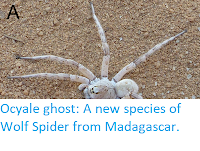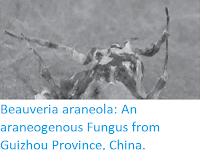Tarantulas, Theraphosidae, are large and usually hairy Mygalomorph Spiders, the group that also includes Trapdoor and Baboon Spiders, and which is noted for features such as non-oposable fangs and only having two pairs of book-lungs. Most Tarantula species are found in the Americas, and while members of this group are found on every continent, most Old World species referred to as 'Tarantulas' are in fact large members of other groups, usually other Mygalomorphs or Wolf Spiders. Tarantulas seldom bite defensively, instead defending themselves
with a dense covering of irritating 'urticating hairs' on their
abdomens, which can be loosed by brushing with the hind legs and wafted
at potential predators, causing irritation to the eyes and nose.
In a paper published in the journal ZooKeys on 21 December 2017, Irene Soliz Revollo of the Instituto de Biociências at the Universidade Estadual Paulista Júlio de Mesquita Filho, and the Laboratório de Ecologia e Evolução at the Instituto Butantan, Pedro Ismael da Silva Júnior of the Laboratório Especial de Toxinologia Aplicada, also at the Instituto Butantan, and Rogério Bertani, again of the Laboratório de Ecologia e Evolução at the Instituto Butantan, describe two new species of Tarantula from Brazil, both of which are placed in the ground-dwelling genus Dolichothele.
The first new species described is named Dolichothele mottai, in honour of the arachnologist Paulo Cesar Motta, for his work on the Mygalomorph Spiders of the Brazilian Cerrado. The species is described from two specimens, a female with a body length of 9.4 cm and a male with a body length of 8.1 cm. Both sexes are covered in iridescent red hairs. The species was found in Cerrado (savanna) environments in the Distrito Federal and state of Goiás, where they build silk tunnels under rocks and logs, males were seen roaming in search of mates in September to November.
The second new species is named Dolichothele camargorum, in honour of Erney Plessmann de Camargo and Luis Marcelo Aranha Camargo, for their work on medical and biological research in the state of Rondônia, Brazil. The species is described from two specimens, a male with a body length of 5.6 cm and a female with a body length of 10.9 cm, both are black and brown with brown hairs. The species was found in Cerrado fragments in Rondônia State in Brazil and the department of La Paz in Bolivia.
See also...
Dolichothele mottai, male specimen. Paulo Cesar Motta in Seliz Revollo et al. (2017).
The second new species is named Dolichothele camargorum, in honour of Erney Plessmann de Camargo and Luis Marcelo Aranha Camargo, for their work on medical and biological research in the state of Rondônia, Brazil. The species is described from two specimens, a male with a body length of 5.6 cm and a female with a body length of 10.9 cm, both are black and brown with brown hairs. The species was found in Cerrado fragments in Rondônia State in Brazil and the department of La Paz in Bolivia.
Dolichothele camargorum, female specimen. Rogério Bertani in Seliz Revollo et al. (2017).
See also...
Follow Sciency Thoughts on
Facebook.








